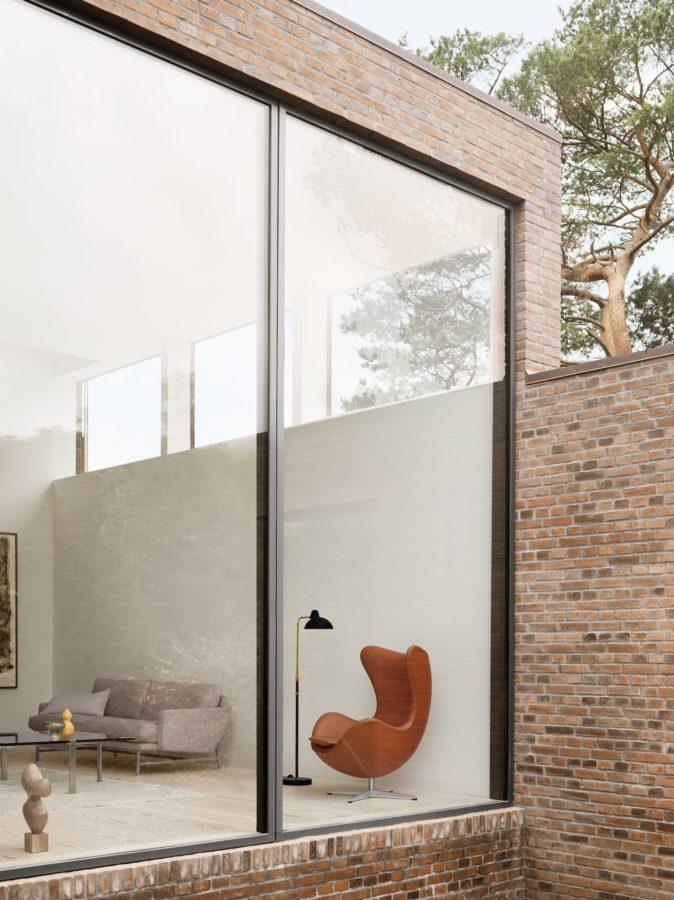Designed in the fifties, the Egg Chair is a design classic that has become one of the most recognisable and copied chairs of all time
 Photography courtesy of Fritz Hansen
Photography courtesy of Fritz Hansen
The original Egg was created by the Danish architect and designer Arne Jacobsen in 1958 for the SAS Royal Hotel in downtown Copenhagen. Jacobsen was commissioned to design every element of the building, from the walls to the furniture, including the cutlery that would be used in the restaurant, the lighting and even the ashtrays. He seized the opportunity to put into practice some ideas he had about how architecture and furniture could be better integrated.
The Egg Chair was the most outstanding part of his entire hotel design and has become a design classic with global success. It broke all design conventions with its curving shape, which Jacobsen was able to achieve by moulding the inner structure out of foam and covering it with upholstery. Jacobsen had experimented with clay in his garage, testing and perfecting the shape, before moving on to sculpting the foam.
The elliptical chair acts as a cocoon around the sitter, gently curving inwards the egg-shape it is named for. It sits atop a star-shaped swivel base, and the angle adjusts to the user’s weight. Designed for the lobby, the hotel was fitted with 50 first edition Eggs. Its curvaceous shape stood out against the straight horizontal and vertical lines of the 22-storey building it inhabited.
 Photography courtesy of Fritz Hansen featuring the Egg chair production, 1960s
Photography courtesy of Fritz Hansen featuring the Egg chair production, 1960s
The foam made the chair incredibly lightweight, ensuring that the hotel staff could move the 50 originals around easily. The 1958 chairs weighed just over 7kg. The materials used today, a more technically advanced foam with glass fibre reinforcement, make the modern iterations slightly heavier. The chair, produced and sold by Fritz Hansen, is now available in a multitude of coloured fabrics and different leathers.
At the same time as designing the Egg – and from the same clay he used to experiment in his garage – Jacobsen also came up with the equally recognisable Swan Chair for the hotel’s lobby. It too features only soft curves in the seat, arms and back.
Jacobsen designed both the Egg and the Swan with matching couches, but only a few of the Egg couches were ever manufactured. The size of the couch made difficult to make and to neatly upholster with cow-hides without leaving unsightly stitching in the middle of its wide seat.
 Photography courtesy of Fritz Hansen featuring Egg lounge chair by Arne Jacobsen, 1958; Kaiser idell lamp by Christian Dell, 1936; Lissoni Sofa by Piero Lissoni, 2006; and, PK65 coffee table by Poul Kjærholm, 1979
Photography courtesy of Fritz Hansen featuring Egg lounge chair by Arne Jacobsen, 1958; Kaiser idell lamp by Christian Dell, 1936; Lissoni Sofa by Piero Lissoni, 2006; and, PK65 coffee table by Poul Kjærholm, 1979
The shape of the Egg chair was era defining and Jacobsen is one of the most imitated designers of the last century. He was a Danish design pioneer, known not only for his many chairs (although these undoubtably made him famous), but also for several notable buildings, including St Catherine’s College, Oxford and the Aarhus City Hall and, of course, the SAS Royal Hotel itself.
Today, the chair – the original as well as the many knock offs, imitations and hanging variations – is still as popular as ever. In recent decades the Egg Chair has taken on a new role in popular culture, having been an iconic part of the reality television series Big Brother as the seat in the diary room, and it was even used in a high-end redesign of London and Copenhagen McDonalds branches, according to The New York Times.
Its popularity has inevitably been helped by a renewed interest in mid-century furniture design but its ergonomic form and revolutionary shape that hinted at the curves and bubble of the decades to come have ensured it has remained a design classic for over half a century.
Get a curated collection of design and architecture news in your inbox by signing up to our ICON Weekly newsletter
















